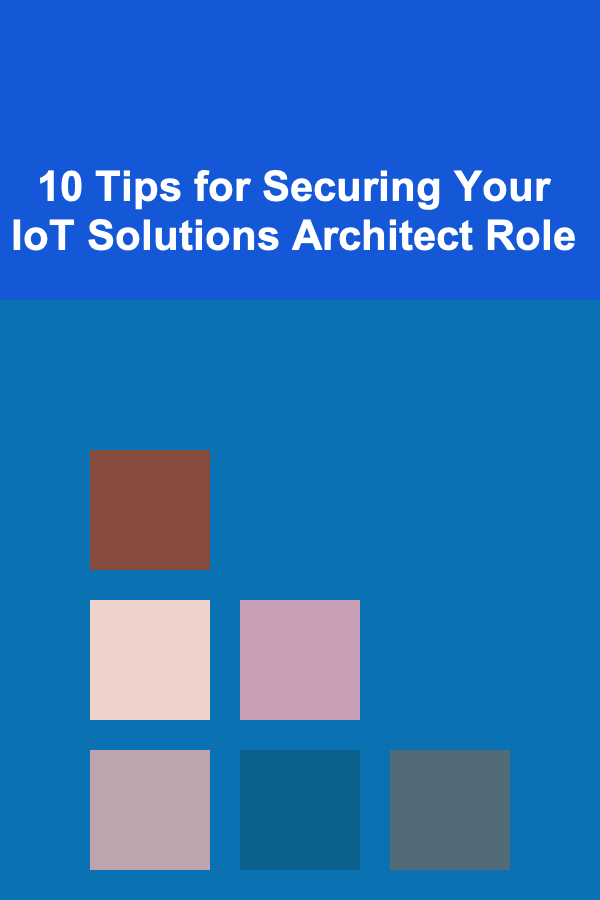
10 Tips for Securing Your IoT Solutions Architect Role
ebook include PDF & Audio bundle (Micro Guide)
$12.99$11.99
Limited Time Offer! Order within the next:

The Internet of Things (IoT) has transformed how businesses operate, connect, and innovate. With IoT solutions spanning various industries---from smart homes to industrial automation---the demand for professionals who can design and implement these systems has risen sharply. One such role, IoT Solutions Architect, has gained immense popularity. As an IoT Solutions Architect, you would be responsible for creating the blueprint and framework for IoT systems that bridge the gap between business needs and technology.
If you're interested in securing a role as an IoT Solutions Architect, there are several critical factors to consider. In this article, we explore ten essential tips that will help you stand out and land your desired position in the growing IoT industry.
Develop a Strong Technical Foundation
The IoT field is highly technical, requiring a deep understanding of various components that make up IoT systems. As an IoT Solutions Architect, you need a solid technical foundation that includes knowledge of networking protocols, data security, cloud platforms, and hardware devices. Here's how to build your technical expertise:
- Networking Protocols: Understand protocols like MQTT, HTTP, CoAP, and others that facilitate communication between IoT devices and servers.
- Embedded Systems: Gain a strong understanding of microcontrollers, sensors, and actuators commonly used in IoT devices.
- Cloud Computing: Be proficient in cloud platforms like AWS, Azure, and Google Cloud, which are integral to IoT solutions for data processing and storage.
- Data Security: Learn how to implement end-to-end encryption, secure communication protocols, and data privacy measures for IoT systems.
The broader and deeper your technical knowledge, the better prepared you will be to design efficient, scalable, and secure IoT solutions.
Learn IoT Architecture Principles
A solid understanding of IoT architecture is vital for any aspiring IoT Solutions Architect. IoT architecture is complex, involving multiple layers like devices, connectivity, edge computing, cloud infrastructure, and applications. Here's how to get familiar with it:
- Layered Architecture: Understand the different layers of IoT architecture, such as perception, network, edge, and application layers.
- Scalability and Flexibility: Learn how to design scalable systems that can handle millions of connected devices while ensuring minimal latency.
- Edge and Cloud Computing: Understand the balance between edge devices processing data locally and cloud servers handling large-scale data analytics.
- Integration: Learn how various IoT components (sensors, actuators, gateways, and cloud systems) interact seamlessly.
Having a strong grasp of IoT architecture allows you to develop solutions that are efficient, cost-effective, and optimized for the needs of the business.
Gain Experience with IoT Platforms
Many companies rely on IoT platforms to simplify the development and management of IoT devices and services. These platforms provide tools and frameworks to connect devices, manage data, and enable analytics. Experience with IoT platforms will help you design robust IoT solutions:
- Popular Platforms: Familiarize yourself with IoT platforms such as AWS IoT Core, Microsoft Azure IoT, Google Cloud IoT, and IBM Watson IoT.
- Platform Integration: Learn how to integrate third-party devices, databases, and analytics tools into these platforms.
- Customization: Understand how to customize these platforms for specific industry requirements, whether it's healthcare, automotive, manufacturing, or retail.
IoT platforms are an essential part of modern IoT solutions, and understanding their capabilities can give you an edge when designing enterprise-level solutions.
Focus on Real-Time Data Processing
IoT systems generate massive amounts of data from sensors and devices in real time. As an IoT Solutions Architect, you'll need to design systems that can handle real-time data processing. Key areas to focus on include:
- Data Stream Management: Learn how to manage continuous data streams from IoT devices, ensuring data is processed, analyzed, and acted upon without delay.
- Data Filtering and Aggregation: Understand how to filter irrelevant data, aggregate meaningful insights, and reduce the load on cloud servers.
- Low-Latency Systems: Design systems with low-latency requirements to ensure fast decision-making, especially in time-sensitive scenarios like autonomous vehicles or industrial automation.
Real-time data processing is crucial for creating IoT solutions that provide actionable insights and drive business value instantly.
Master IoT Security Best Practices
Security is one of the most critical aspects of IoT solutions. With the increasing number of connected devices, IoT systems are vulnerable to cyber-attacks. As an IoT Solutions Architect, ensuring the security of the system is your responsibility. Some best practices to follow include:
- End-to-End Encryption: Ensure that data is encrypted from the device to the cloud and that all communication channels are secure.
- Device Authentication: Implement robust device authentication mechanisms, including certificates, secure keys, and identity management.
- Data Privacy: Understand and implement privacy regulations like GDPR and CCPA, ensuring that personal data is securely handled.
- Secure Firmware: Make sure that the firmware on IoT devices is regularly updated to fix vulnerabilities.
Securing IoT systems is an ongoing challenge, but mastering security principles will make you an invaluable asset to any organization looking to deploy connected devices.
Understand Business Requirements
IoT solutions are not just about technology; they must also align with business goals. To be an effective IoT Solutions Architect, you need to understand the business context in which the IoT solution will operate. Here's how you can align your technical designs with business needs:
- Identify Pain Points: Work with business stakeholders to identify pain points and inefficiencies that IoT technology can address, such as supply chain management or predictive maintenance.
- Cost-Effectiveness: Design IoT solutions that are cost-effective, ensuring that the implementation and operational costs are within budget while maximizing value.
- Return on Investment (ROI): Develop solutions that deliver measurable results, whether it's reducing downtime, enhancing customer experience, or improving product quality.
- Compliance: Ensure that your IoT solutions comply with industry regulations and standards, especially in sectors like healthcare or finance.
Your ability to bridge the gap between business objectives and technological requirements will make you an indispensable part of the organization.
Develop Strong Communication and Collaboration Skills
An IoT Solutions Architect often works with cross-functional teams, including software developers, hardware engineers, business stakeholders, and even external partners. Effective communication and collaboration are essential to delivering successful IoT solutions:
- Stakeholder Management: Be able to clearly articulate technical concepts to non-technical stakeholders and ensure their requirements are reflected in the solution.
- Team Collaboration: Work closely with developers, product managers, and other engineers to implement the IoT solution, ensuring everyone is on the same page.
- Presentation Skills: Present your solution effectively to senior management, clients, or other key stakeholders, highlighting its business value and technical benefits.
Clear communication ensures that everyone understands their role in the project and that the IoT solution meets both technical and business goals.
Stay Updated on Emerging Trends
The IoT industry is rapidly evolving, with new technologies and trends constantly emerging. As an IoT Solutions Architect, you need to stay informed about the latest developments to stay competitive in the job market:
- Edge Computing: Understand how edge computing is changing the way data is processed in IoT systems, enabling faster decision-making and reducing cloud dependency.
- 5G Networks: Learn how the rollout of 5G will enhance IoT capabilities by providing faster and more reliable connectivity.
- Artificial Intelligence and Machine Learning: Explore how AI and ML are being integrated with IoT to drive intelligent automation, predictive analytics, and anomaly detection.
- Blockchain for IoT: Understand how blockchain is being used to secure IoT devices, ensuring data integrity and preventing fraud.
By staying updated on emerging technologies, you can position yourself as a forward-thinking architect capable of designing future-proof IoT solutions.
Pursue Relevant Certifications
While hands-on experience is critical, certifications can also boost your credentials and make you a more attractive candidate for an IoT Solutions Architect role. Some notable certifications include:
- AWS Certified Solutions Architect: An industry-recognized certification for those working with AWS cloud platforms and IoT services.
- Microsoft Certified: Azure IoT Developer: For those focusing on IoT solutions using Microsoft Azure.
- Cisco Certified Network Associate (CCNA): A foundational certification for networking professionals, which is crucial for understanding IoT networking protocols.
These certifications demonstrate your commitment to the field and validate your expertise in key areas related to IoT solutions.
Build a Portfolio of Projects
Finally, a strong portfolio showcasing your IoT projects can give you a significant edge over other candidates. Whether you've built IoT prototypes, worked on research projects, or contributed to open-source IoT initiatives, a portfolio serves as concrete evidence of your abilities. To build your portfolio:
- Prototype IoT Solutions: Design and implement IoT solutions for real-world problems, such as home automation, smart agriculture, or industrial monitoring.
- Document Your Work: Create detailed documentation for each project, including the problem, solution, architecture, and results. Highlight the technologies and tools you used.
- Share Your Code: Contribute to open-source projects or share your code on platforms like GitHub, where potential employers can review your work.
A strong portfolio not only demonstrates your technical skills but also shows that you have practical experience in designing and implementing IoT solutions.
Conclusion
Securing a role as an IoT Solutions Architect requires a blend of technical expertise, business acumen, and soft skills. By developing a strong technical foundation, mastering IoT architecture principles, gaining experience with IoT platforms, and continuously improving your knowledge, you can position yourself as a highly qualified candidate for this exciting and rapidly growing role. Whether you're just starting out or looking to advance your career, these ten tips will help guide you toward a successful IoT Solutions Architect position.
Reading More From Our Other Websites
- [Personal Investment 101] How to Use Investment Apps for On-the-Go Management
- [Home Space Saving 101] How to Downsize Your Home Without Sacrificing Comfort or Style
- [Home Lighting 101] How to Choose the Best Lighting for a Garage Gym: Optimizing Visibility and Creating an Energetic Atmosphere
- [Home Family Activity 101] How to Organize Fun Game Nights for the Whole Family
- [Home Staging 101] How to Stage Your Home During the Holidays to Appeal to Buyers
- [Home Maintenance 101] How to Effectively Use the Invitation Homes Maintenance Line for Quick Repairs
- [Home Maintenance 101] How to Maintain Your Home's Appliances to Save Energy
- [Home Party Planning 101] How to Organize a Backyard Party: What Are the Best Tips for a Perfect Gathering?
- [Organization Tip 101] How to Create a Weekly Meal Plan Using Pantry Staples
- [Simple Life Tip 101] Best Simple‑Meal Planning Strategies for Busy Families on a Budget

Beyond Sales: Building Long-Term Relationships Through Customer Success Management
Read More
How to Protect Your Assets with Proper Insurance Coverage
Read More
How to Shop Smart for Seasonal Home Accessories
Read More
How to Update Your Home's Entryway for a Welcoming Feel
Read More
How to Negotiate Your Remote Work Salary
Read More
How to Plan a Podcast Interview Workflow: From Pitch to Publication
Read MoreOther Products

Beyond Sales: Building Long-Term Relationships Through Customer Success Management
Read More
How to Protect Your Assets with Proper Insurance Coverage
Read More
How to Shop Smart for Seasonal Home Accessories
Read More
How to Update Your Home's Entryway for a Welcoming Feel
Read More
How to Negotiate Your Remote Work Salary
Read More